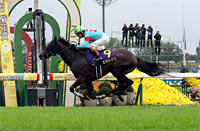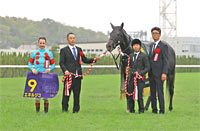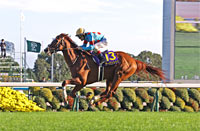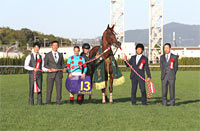Kikuka Sho (Japanese St. Leger) (G1) - Data Analysis
Final leg of Classic races for 3-year-olds brings clash between spring standouts and new names
Boldog Hos, who was beaten by a nose in last year’s Kikuka Sho (Japanese St. Leger) to 2nd place, went on to deliver another strong performance in his next race, finishing as runner-up in the Arima Kinen (The Grand Prix). Similarly, third-place finisher Justin Palace in 2022 dominated the Tenno Sho (Spring) of 2023, thereby becoming a G1 winner. In addition to being the final leg of the Triple Crown races, the Kikuka Sho should also be watched as an indicator of contenders for future long-distance race for older horses. Let’s now analyze some features shared by successful runners in this race based on results over the last 10 years, including the 2021 and 2022 races held as 3,000m turf races at Hanshin Racecourse.
Runners that were strong performers last time out essentially have the edge
Of the 30 Top 3 finishers over the last 10 years, 27 had finished in the Top 3 of their previous race. Meanwhile, runners that had finished 4th or lower last time out struggled with a Top 3 ratio of 3.8%. We should therefore lower our expectations of runners that have finished 4th or lower in their previous race. [Table 1]
[Table 1] Performance by finish in previous race (last 10 years)
| Finish in previous race |
Performance
[1st-2nd-3rd-4th or lower] |
Win ratio |
Top 2 ratio |
Top 3 ratio |
| Top 3 |
9-9-9-75 |
8.8% |
17.6% |
26.5% |
| 4th or lower |
1-1-1-75 |
1.3% |
2.6% |
3.8% |
In addition, the three Top 3 finishers that had finished 4th or lower in their previous race, had all finished in the Top 4 of Satsuki Sho (Japanese 2000 Guineas). This suggests that runners with a strong showing last time out, and those that chased the top places in the Satsuki Sho tend to fare well in this race. [Table 2]
[Table 2] Among runners that had finished 4th or lower in their previous race, performance by experience of finishing in the Top 4 of the Satsuki Sho (Japanese 2000 Guineas) (last 10 years)
| Experience |
Performance
[1st-2nd-3rd-4th or lower] |
Win ratio |
Top 2 ratio |
Top 3 ratio |
| Yes |
1-1-1-3 |
16.7% |
33.3% |
50.0% |
| No |
0-0-0-72 |
0% |
0% |
0% |
Record from April onward is a key factor
Of the 30 Top 3 finishers over the last 10 years, 25 had experience of finishing in the Top 4 of a JRA G1 or G2 race held since April of the same year. We should therefore be skeptical of runners without such experience. [Table 3]
[Table 3] Performance by experience of finishing in Top 4 of JRA G1 or G2 race held since April of same year (last 10 years)
| Experience |
Performance
[1st-2nd-3rd-4th or lower] |
Win ratio |
Top 2 ratio |
Top 3 ratio |
| Yes |
9-9-7-64 |
10.1% |
20.2% |
28.1% |
| No |
1-1-3-86 |
1.1% |
2.2% |
5.5% |
In addition, among the five Top 3 finishers without experience of finishing in the Top 4 of a JRA G1 or G2 race held since April of the same year, three had experience of winning “a JRA 2,200m race held since August of the same year.” Runners without such experience struggled with a Top 3 ratio of 2.4%. [Table 4]
[Table 4] Among runners without experience of finishing in Top 4 of JRA G1 or G2 race held since April of same year, performance by experience of winning “JRA 2,200m race held since August of same year.” (last 10 years)
| Experience |
Performance
[1st-2nd-3rd-4th or lower] |
Win ratio |
Top 2 ratio |
Top 3 ratio |
| Yes |
0-1-2-5 |
0% |
12.5% |
37.5% |
| No |
1-0-1-81 |
1.2% |
1.2% |
2.4% |
Focus on runners with 8 or fewer career starts
Of the 30 Top 3 finishers over the last 10 years, 28 had 8 or fewer career starts. Conversely, runners with 9 or more career starts struggled with a Top 3 ratio of 3.3%. In other words, we need to discount runners with 9 or more career starts. [Table 5]
[Table 5] Performance by total career starts (last 10 years)
| Total career starts |
Performance
[1st-2nd-3rd-4th or lower] |
Win ratio |
Top 2 ratio |
Top 3 ratio |
| 8 or fewer |
10-8-10-91 |
8.4% |
15.1% |
23.5% |
| 9 or more |
0-2-0-59 |
0% |
3.3% |
3.3% |
Runners entering the race after a rest period have fared poorly in recent years
All 12 Top 3 finishers in the last four years entered the race five weeks or less since their previous race. Up to 2018, runners who entered the race six weeks or more after their previous race performed decently, but if trends in recent years are anything to go by, we should probably lower our expectations of runners entering the race after a rest period. [Table 6]
[Table 6] Performance by period since previous race (last four years)
| Period since previous race |
Performance
[1st-2nd-3rd-4th or lower] |
Win ratio |
Top 2 ratio |
Top 3 ratio |
| Five weeks or less |
4-4-4-44 |
7.1% |
14.3% |
21.4% |
| Six weeks or more |
0-0-0-16 |
0% |
0% |
0% |
Distance of previous race also a key point to watch
All 12 Top 3 finishers in the last four years had contested a race with a distance above 2,000m but below 2,500m in their previous race. If trends in recent years are anything to go by, we should expect lackluster performance from runners that have contested races with distances of either 2,000m or less or 2,500m+ in their previous race. [Table 7]
[Table 7] Performance by distance of previous race (last four years)
| Distance of previous race |
Performance
[1st-2nd-3rd-4th or lower] |
Win ratio |
Top 2 ratio |
Top 3 ratio |
| 2,000m or less |
0-0-0-13 |
0% |
0% |
0% |
Above 2,000m
but below 2,500m |
4-4-4-38 |
8.0% |
16.0% |
24.0% |
| 2,500m+ |
0-0-0-9 |
0% |
0% |
0% |
Seek out the winner!
Focus on runners with fewest reasons for uncertainty
The last four winners all had experience of finishing in the Top 3 of a JRA G1 or G2 race held since April of the same year. Other shared features among the four winners were that they had 8 or fewer career starts, that the period since their previous race was four weeks or less, and that they had contested a race with a distance above 2,000m but below 2,500m in their previous race. In other words, runners that clear the conditions outlined in Table 3, Table 5, Table 6, and Table 7 should be regarded as leading contenders. [Table 8]
[Table 8] Winners’ highest finish in JRA G1 or G2 race held since April of same year, total career starts, period since previous race, and distance of previous race (last four years)
| Year |
Winner |
Highest finish in JRA G1 or G2 race held since April of same year |
Total career starts |
Period since previous race |
Distance of previous race |
| 2019 |
World Premiere |
3rd, Kobe Shimbun Hai (Japanese St. Leger Trial) |
5 |
Three weeks |
2,400m |
| 2020 |
Contrail |
1st, Tokyo Yushun
(Japanese Derby) |
6 |
Three weeks |
2,200m |
| 2021 |
Titleholder |
2nd, Satsuki Sho
(Japanese 2000 Guineas) |
7 |
Four weeks |
2,200m |
| 2022 |
Ask Victor More |
2nd, Asahi Hai St. Lite Kinen (Japanese St. Leger Trial) |
8 |
Four weeks |
2,200m |
(Masaya Ibuki)
|





















